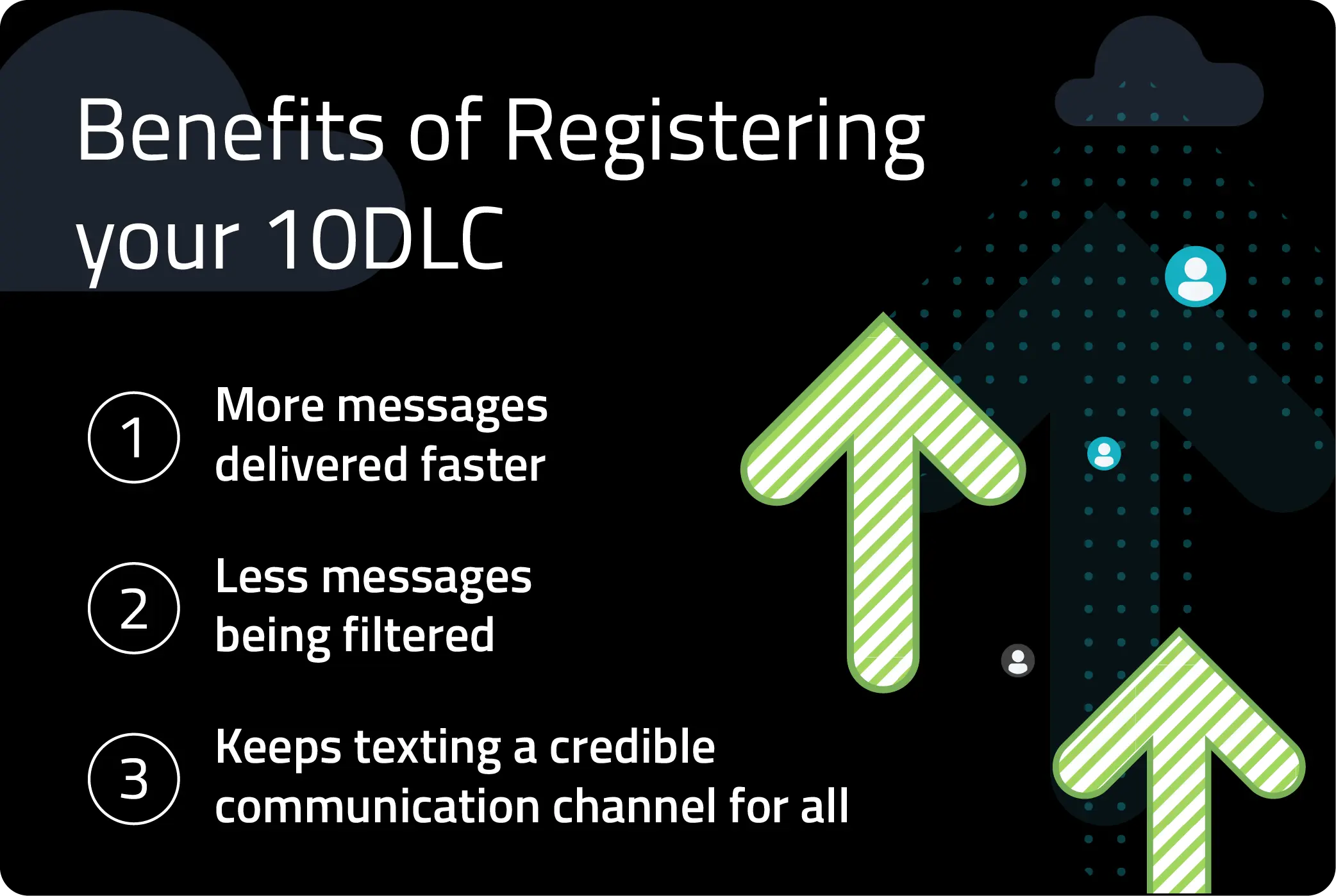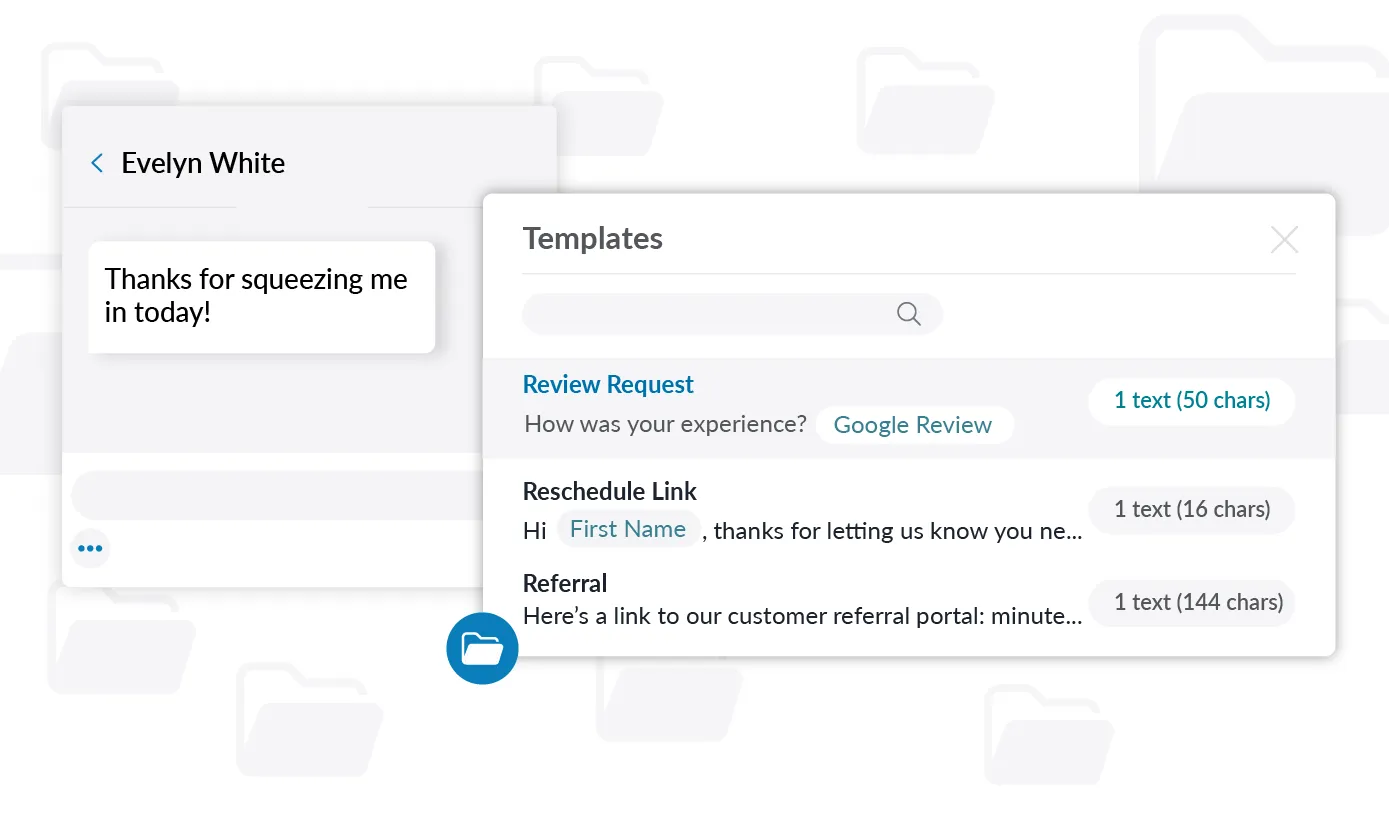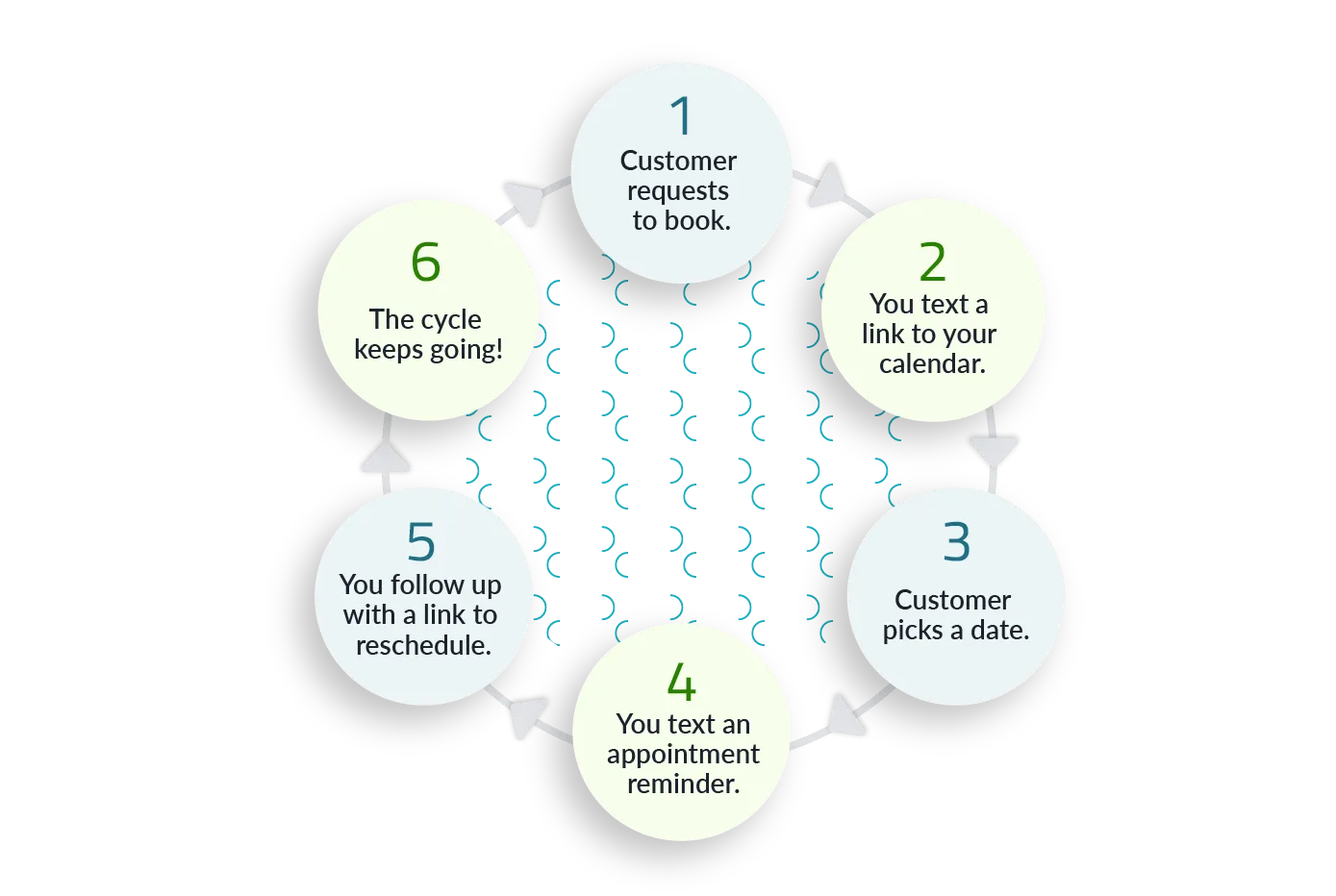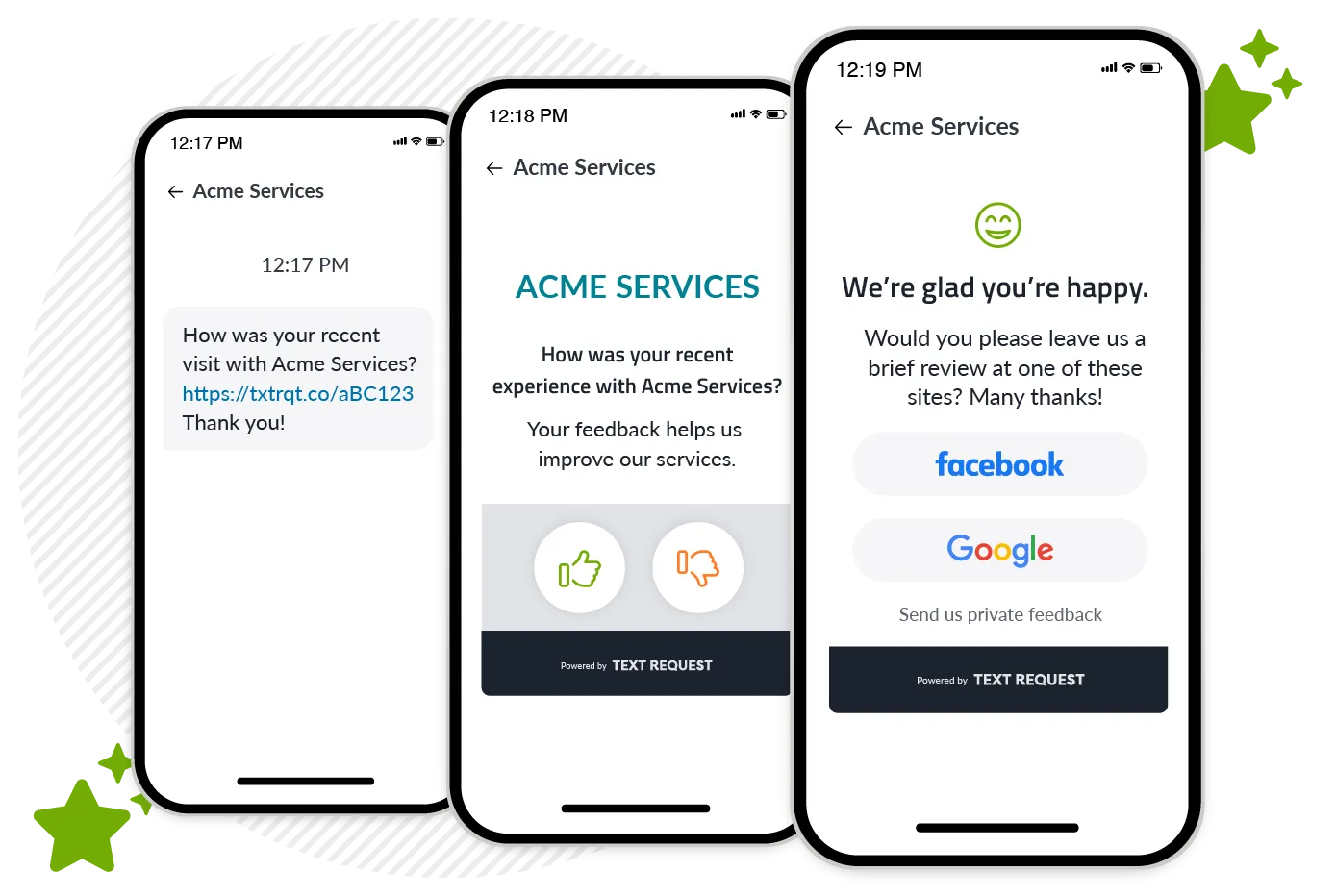Playbook
Healthcare Text Messaging
Text messaging helps medical professionals get patients the care they need faster and more effectively.
It opens the door for more one-on-one conversations about health, but in a discrete and familiar way that patients prefer.
This playbook will show you how your medical facility can securely share Protected Health Information (PHI), updates and reminders, files, and images via text message to create better patient experiences across your healthcare system.
Is texting HIPAA compliant?
Yes, texting can be HIPAA compliant, but only if it’s done through software that meets the security, governance, and operational requirements specified by the Health Insurance Portability and Accountability Act, and other associated regulations.
We’ll save you the trouble—Text Request has HIPAA Compliant Texting accounts. All data is permanently recorded, encrypted in transit and at rest, and our security is certified by third party auditors. We’ll even sign a Business Associate Agreement (BAA) with you upon request. Check out our security page to learn more.
This means you can text back-and-forth with patients at will. They don’t have to download an app—it’s just normal texting—and you can provide the best care possible.
Note: A HIPAA Compliant platform with these security standards is necessary to implement the strategies we cover below.
5 Texting Essentials Your Health System Needs First
1. Permission to text your patients.
Part of texting compliantly is ensuring patients have opted in to receive texts from you. They also need to opt in to sharing personal health info (PHI).
There’s a difference between texts for scheduling appointments vs. texts sharing test results and following up for treatment reminders. You account for this difference by asking patients if they’re okay with both.
The most clear-cut way for your health system to document opt-ins is by adding a spot for a phone number in your patient sign-in or contact information forms.
2. 10DLC registration for your office phone number(s).
Mobile carriers want you to register your business phone number for texting, so they know whose traffic is legitimate and whose is spam.
10DLC stands for 10-digit long code number. It’s a standard phone number, like 423-218-0111, that you most likely already use to call patients. Registering this number will keep your texts from getting filtered by mobile carriers.
It’s all intended to keep text messaging a quality channel for you and your patients. Text Request directs you through the 10DLC registration process when you create an account.
3. A contact list for importing.
Patients who’ve previously worked with you before have already informally consented to receiving texts for basic communications. That said, you’ll still want to message them to ask if they’d like to opt in for regular scheduling, updates, and other kinds of text messaging.
You’ll start this process by exporting your existing contacts from your practice management software or CRM, and uploading them into Text Request.
Create a new spreadsheet with:
Phone numbers in column A
Patient names in column B
Export the spreadsheet as a CSV (Comma Separated Values) file, and it’ll be ready to pop into Text Request with one drag and drop. Our support team can comb through your list to determine which are mobile phone numbers and which are landlines.
This way your clinicians have everything they need to start texting patients to see if they’d like to opt in for regular messages.
4. A plan to ramp up messaging.
It can be tempting to start texting all your patients on Day 1—and we love that energy—but carriers will get suspicious if you go from texting no one to texting hundreds or thousands of patients that quickly.
Spread your messages out over time, based on applicable treatments that pop up, or folks who need upcoming appointment reminders. Our guide on spam messaging will walk you through on more top tips to avoid catching carriers’ attention.
5. A review link and patient survey to share.
Potential patients will read your reviews before they seek treatment at a new healthcare facility. That’s why asking for them after a patient visits needs to be a part of your care process.
You also need internal surveys to document ways your healthcare facility can improve, so you can continue to create 5-star patient experiences they rave about online. Even if most of your business is through word of mouth, you want to leverage reviews and testimonials in your marketing to keep existing patients engaged and coming back.
We’ll cover later how you can use Text Request to share review and internal surveys links to patients. We have a full guide dedicated to why gathering online reviews is important and how Text Request can help.
10 Ways Healthcare Providers Can Implement Texting Into Patient Care
1. Text from your healthcare facility’s landline number.
Patients are already used to contacting you through your landline number. They don’t want to learn a new one, and you don’t want to teach them.
Text Request can add texting to your current line without affecting your voice services. You get to keep your number patients are familiar with, and none of your marketing materials have to be updated.
You can have multiple lines under one account, which gives your medical staff a lot of flexibility—like say if you wanted each physician or department to have their own line. You can even manage user permission levels, so medical staff can only see the lines you need them to.
Your doctors are pretty much always on call, but now they’ll be able to text through your healthcare facility’s phone number at any time!
2. Provide telehealth to speed up better health outcomes.
Being able to securely text PHI opens the door to the quality and speed of care you can provide. You no longer have to play phone tag because you can’t share information over a voicemail. Instead, you can text the patient directly for things like:
Requesting their personal details to fill out their health profiles
Sharing test results
Discussing next steps
Opening a dialogue for them to express their health concerns
Following up after treatments with reminders and status updates (more on this later)
Your medical staff will no longer lose valuable time waiting to get a missing address on a form, or for test results to physically arrive in the mail.
3. Use SMS Chat to attract more new patients.
Potential patients want to work with a healthcare team that gets back to them ASAP. They also want to communicate with you in a way that is private and comfortable, while being able to ask questions they need answered before they schedule—whether it’s about health insurance or treatment or something else.
Text messaging gives you the power to do all of this—but how do you let new patients know they have the option to text you?
Use an SMS Chat widget on your website to capture patients’ attention by letting them text you directly from your website. It’s the perfect solution for a new patient who wants to communicate with you discreetly, or for a patient who is in panic mode and needs to talk to a healthcare professional ASAP.
Giving patients the power to communicate with you the way they most prefer will draw more of them to you. Businesses that add an SMS Chat widget to their website tend to see an increase in qualified conversations of about 30%, and an increase in conversions of 50-100%, because they can follow up via text even after that person leaves the website.
All this positively impacts your healthcare facility’s foot traffic and bottom line.
4. Incorporate SMS scheduling to prevent missed appointments.
Constantly calling to schedule appointments and reminders is a major timesuck. You almost never reach the patient you’re trying to reach, and your team usually ends up leaving a voicemail that’s never listened to, which results in a missed appointment.
Schedule regular check-ups or share last minute appointment openings by text. SMS appointment scheduling is faster, easier, and will save time by cutting down on phone calls. Healthcare patients who miss just one appointment have only a 30% chance of coming back within 18 months—but SMS reminders cut no-shows by 50%.
Here’s a SMS scheduling process your healthcare center:
1. Prompt patients to text you to book schedule their next appointment, then share your scheduling link when they reach out.
2. Text appointment confirmations and reminders. Share any updates along the way, as well as what patients should expect, so they don’t get cold feet. If they can't make it, text a link to reschedule and announce the open slot to other patients.
3. Keep it going. Text patients to set their next appointment as soon as their current one is over.
That kind of workflow means more revenue in your healthcare system’s bank and less scheduling headaches for medical staff to deal with.
5. Conduct follow-ups and post appointment care by text.
Quick post-care follow-ups with patients are fastest with text messaging. It only takes one short message to:
Check-in to see how the patient is doing or what their pain level is at
Share reminders about when to take pills or do exercises
Provide educational tips on what stage of recovery the patient is in, or how they should be feeling
There’s plenty of room for these touch points to turn into full text conversations—and often that’s where some of the best patient experiences come from.
We have mobile apps to make it easy for clinicians to handle these conversations on the go. That way they can keep working as they see other patients. The amount of phone calls this cuts out is huge for getting time back into their busy day.
6. Share surveys and review links via SMS.
Remember those online review links and surveys we talked about earlier? Now we’re going to text them to patients.
Document when new patients first see you, so you can reach out with a survey or review link after they’ve worked with you for long enough. This amount of time will vary depending on if you’re a primary care provider or specialist.
Then you can text a custom review link using Text Request. Here’s how:
Connect your Google Business or Facebook page to Text Request
Insert custom reviews links into your texts asking customers for feedback
Monitor and respond to oncoming reviews from inside Text Request
Text messaging is the fastest way to reach your current customers for reviews, and Text Request gives you one place to manage them.
7. Request and process patient payments.
Collecting patient payments keeps your healthcare facility running, but that doesn’t mean it has to take up time. Request secure payments from patients by text, and everyone will have a better experience.
Typically the patient will visit, you’ll send the details of their visit to insurance, insurance will get back to you on how much they’ll cover, then you mail the final invoice to the patient.
Instead of mailing, which is expensive, time consuming, and causes so many patients to miss their bills, just text the payment request instead. You’ll speed up cash flow, be available to handle any questions ASAP, and reduce costs all in one swoop!
Our Payments feature gives your healthcare facility the power to request and collect payments by SMS, plus track revenue all in one place. The amount owed and link to pay are automatically included when you send a payment request.
The first time a patient pays through text, they’ll click a link to enter their payment info. Info is saved for future payments, where they reply with a confirmation code. Then everything is saved and good to go for their next visit!
Patients will love being able to manage invoices from their mobile phone, and staff will love being able to track everything in one place. Transactions are processed in real-time, so everyone’s day can keep chugging along.
8. Promote seasonal care reminders and check-up offers.
Keep patients coming to your healthcare organization with educational texts about why your health services matter or offers for discounted seasonal check-ups.
Patients won’t know the pain points of missing appointments, unless you tell them. Texts can be a way to get that information in front of them and make sure they read it, including:
Why regular blood work matters
Different allergens that may be bothering patients during a particular season
Discounted cholesterol test opportunities
Reminders on how often to apply sunscreen during the summer
Free dental cleanings
Reminders that eye exams are annually required to refill contact prescriptions
Infographics on benign vs malignant moles
And so much more
There are tons of ways for your medical staff to use text messaging to get patients engaged in their health, whether it’s general or specialized.
9. Provide general updates and announcements.
Have updates about new hours, equipment, services, or plans for renovation? Keeping patients in the loop about those new things is key for your continued growth. Mass Texting lets you reach all your patients at once so they know what you have to offer.
Mass Texting works like BCC email, so any individual replies stay between you and the patient. That means you can handle questions as they come in and continue to provide individualized care. Patients will have better experiences with your practice when you use text messaging as a way to keep them in the loop.
10. Re-engage overdue patients.
Sometimes that patient you haven’t seen in a year or two just needs a nudge. Make it easy for them to schedule by including a text in the message, and they’ll take the bite.
There are tons of reasons a patient may stop getting care, but most likely it’s because they’re caught up in their daily lives and haven’t bothered to take time to schedule an appointment. That’s where texting a link to create an appointment can make a world of difference.
A great time to send these links are when you have a last minute cancellation that you need to fill.
“Hey [Name], a [service/treatment] slot just opened up tomorrow at [time]. We know it’s been [duration] since your last [service/treatment], would you like to take this slot? [link] You can use that link to book it.”
Voicemails and emails won’t have nearly the same effect, because they get lost in the noise—but texts are seen every time. Regularly stay in touch with patients via text message, and you’ll see more of them.
Ready to Start Texting at Your Medical Practice?
Schedule a demo to talk to our sales team about the use cases that are most important to your medical staff. They’ll show you the best SMS strategies to compliment your needs, as well as what it’d look like to use Text Request day-to-day.
We can send our BAA agreement as part of the process, plus direct you to one-on-one trainings to help your healthcare providers get the most out of text messaging.









